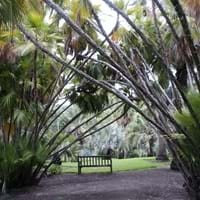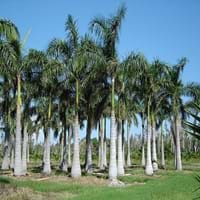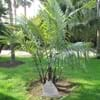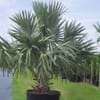Life Span
Perennial
Perennial
Type
Palm or Cycad
Palm or Cycad
Origin
Southeastern United States, Mexico, Caribbean, Central America
Australia
Types
Not Available
Coconut and Dates
Habitat
Low Elevation, Muddy habitat, Open Forest
tropical environments
USDA Hardiness Zone
8-14
Not Available
AHS Heat Zone
12-9
Not Available
Sunset Zone
H1, H2, 22, 23, 24
Not available
Habit
Clump-Forming
Upright/Erect
Flower Color
Light Yellow, Ivory
White, Yellow
Flower Color Modifier
Bicolor
Bicolor
Fruit Color
Orange, Black
Orange, Orange Red
Leaf Color in Spring
Green, Light Green
Brown
Leaf Color in Summer
Green, Light Green
Not Available
Leaf Color in Fall
Green, Light Green
Not Available
Leaf Color in Winter
Green, Light Green
Not Available
Leaf Shape
imparipinnate
feather-shaped
Plant Season
Spring, Summer, Fall, Winter
Spring, Summer, Fall, Winter
Sunlight
Full Sun, Partial Sun, Partial shade
Bright Indirect Sunlight
Growth Rate
Slow
Not Available
Type of Soil
Clay, Loam, Sand
Light, Loose, Moist
The pH of Soil
Acidic, Neutral, Alkaline
Acidic
Soil Drainage
Average
Well drained
Bloom Time
Early Spring, Spring, Late Spring, Early Summer, Summer, Indeterminate
All year
Repeat Bloomer
No
Not Available
Tolerances
Wet Site, Drought, Salt, Soil Compaction
Not Available
Where to Plant?
Container, Ground
Ground, Pot
How to Plant?
Root Division
Rooted stem cutting, Seedlings
Plant Maintenance
Medium
Low
Watering Requirements
Average Water Needs, Keep ground moist, Never Over-water, Water regularly for 2 months
Average Water Needs, Needs 2-3 times watering per week, Water daily during growing season
In Summer
Lots of watering
Lots of watering
In Spring
Moderate
Moderate
In Winter
Average Water
Less Watering
Soil pH
Acidic, Neutral, Alkaline
Neutral
Soil Type
Clay, Loam, Sand
Not Available
Soil Drainage Capacity
Average
Well drained
Sun Exposure
Full Sun, Partial Sun, Partial shade
Not Available
Pruning
Remove damaged leaves, Remove dead branches, Remove dead leaves
Remove damaged leaves, Remove dead branches, Remove dead leaves, Remove old, faded fronds
Fertilizers
All-Purpose Liquid Fertilizer
Boron, EDTA iron, Maganese, Magnesium, Nitrogen, Potassium
Pests and Diseases
Red blotch
Red blotch
Plant Tolerance
Drought
Not Available
Flowers
Insignificant
Yes
Flower Petal Number
Single
Not Available
Edible Fruit
No
Not Available
Fragrant Flower
No
Not Available
Fragrant Fruit
No
Not Available
Fragrant Leaf
No
Not Available
Fragrant Bark/Stem
No
Not Available
Showy Foliage
Yes
Not Available
Showy Bark
No
Not Available
Foliage Texture
Coarse
Not Available
Foliage Sheen
Matte
Glossy
Invasive
No
Not Available
Self-Sowing
Yes
Not Available
Attracts
Birds
Bees, Bugs, Insects, Mice, Rats, Rodents
Allergy
Not Available
Asthma, Rhinitis
Aesthetic Uses
Bog Garden, Water gardening
Decorating walls, Landscape Designing, Showy Purposes
Beauty Benefits
Not Available
Making cosmetics
Environmental Uses
Air purification
Air purification, Shadow Tree
Medicinal Uses
Not Available
Aging, Brain disease, Cancer, Cyanide Poisoning, High blood pressure, High cholestrol, Malaria, Metabolic disorders, Vitamin A, Weight loss
Part of Plant Used
Bark, Fruits, Leaves, Root, Wood
Fruits, Leaves, Tree trunks
Other Uses
Used as firewood, used for making charcoal
Biodiesel, For making oil, Jelly, Sometimes used for making wine, Used in salads, Wax
Used As Indoor Plant
Yes
No
Used As Outdoor Plant
Yes
Yes
Garden Design
Container, Feature Plant, Foundation, Mixed Border, Screening / Wind Break, Tropical
Tropical
Botanical Name
ACOELORRHAPHE wrightii
ARCHONTOPHOENIX
Common Name
Everglades Palm, Paurotis Palm, Silver Saw Palm, Wright Palm
Palm
In Hindi
Paurotis Palm
Palm
In German
Paurotis Palm
Palme
In French
Palmier des Everglades, Paurotis de Wright
Paume
In Spanish
Papta, Pimenta, Palma (Belize), Tiqui (Honduras)
Palma
In Greek
Paurotis Palm
Παλάμη
In Portuguese
Palmeira-paorotis
Palma
In Polish
Paurotis Palm
Palma
In Latin
Paurotis Palm
Vero
Phylum
Tracheobionta
Magnoliophyta
Class
Liliopsida
Liliopsida
Family
Arecaceae
Arecaceae
Genus
Acoelorrhaphe
Archontophoenix
Clade
Angiosperms, Commelinids, Monocots
Angiosperms, Commelinids, Monocots
Subfamily
Coryphoideae
Arecoideae
Number of Species
Not Available
Importance of Paurotis Palm and Palm Tree
Want to have the most appropriate plant for your garden? You might want to know the importance of Paurotis Palm and Palm Tree. Basically, these two plants vary in many aspects. Compare Paurotis Palm and Palm Tree as they differ in many characteristics such as their life, care, benefits, facts, etc. Every gardener must at least have the slightest clue about the plants he wants to plant in his garden. Compare their benefits, which differ in many ways like facts and uses. The medicinal use of Paurotis Palm is Not Available whereas of Palm Tree is Aging, Brain disease, Cancer, Cyanide Poisoning, High blood pressure, High cholestrol, Malaria, Metabolic disorders, Vitamin A and Weight loss. Paurotis Palm has beauty benefits as follows: Not Available while Palm Tree has beauty benefits as follows: Not Available.
Compare Facts of Paurotis Palm vs Palm Tree
How to choose the best garden plant for your garden depending upon its facts? Here garden plant comparison will help you to solve this query. Compare the facts of Paurotis Palm vs Palm Tree and know which one to choose. As garden plants have benefits and other uses, allergy is also a major drawback of plants for some people. Allergic reactions of Paurotis Palm are Not Available whereas of Palm Tree have Asthma and Rhinitis respectively. Having a fruit bearing plant in your garden can be a plus point of your garden. Paurotis Palm has showy fruits and Palm Tree has showy fruits. Also Paurotis Palm is not flowering and Palm Tree is flowering. You can compare Paurotis Palm and Palm Tree facts and facts of other plants too.





